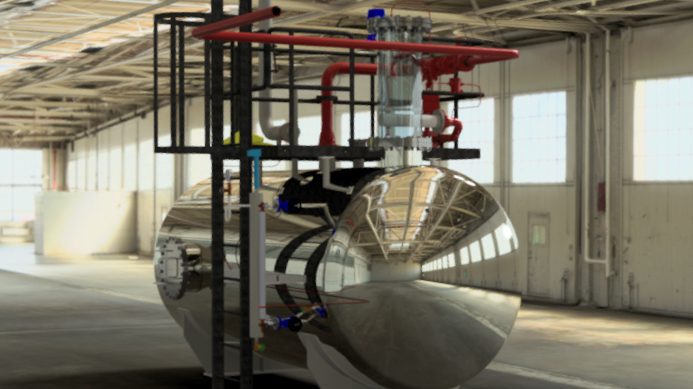A deaerator removes gases from the boiler water to prevent damage to the system. Standard Fasel supplies various types of deaerator and will be happy to advise you on the optimal choice for your steam system.
Prevent damage with a deaerator
Water to produce steam is obviously a necessity for steam boiler operation. After generation, steam is often lost again in the process. These losses must be replenished with new water. We call this make-up water. Ordinary tap water is usually used for this purpose, however the quality of tap water is not sufficient to allow direct use in the steam generation process. This is because tap water also has other substances dissolved in it, such as calcium, salts, minerals and also gases such as oxygen, carbonic acid gas, carbon dioxide and nitrogen. All these components can be harmful for a steam system.
So the water needs to be treated before adding it to the steam system. Water treatment (filtration, softening, demineralisation, dealkalisation) removes most harmful components from the water, except for the gases. Mainly the oxygen and to a lesser extent carbonic acid gas and carbon dioxide should be removed to prevent corrosion in the boiler. A deaerator removes these gases from the system, preventing damage. Using a good deaerator extends the life of your steam system and prevents unnecessary downtime due to repairs.

Different types of deaerator
Standard Fasel produces two types of thermal deaerators; a thermal deaerator without a dome (spray deaerator) and one with a dome (cascade deaerator).
Thermal deaerator without a dome (spray deaerator)
The operation of the thermal deaerator is based on the physical law that oxygen and other dissolved gases escape (as gas bubbles) if you bring water to its boiling point for long enough. Process steam, reduced to a pressure of 0.2 bar(g), provides the heat required.
The steam is distributed at the bottom of the tank through several spray nozzles. The heat from the steam, and movement in the water caused by the steam, force the gases out of the water and they leave the tank through a vent at the top of the unit. This opening is sized to maintain the required pressure. The fresh make-up water is sprayed in at one side of the tank and pumped out from the other side towards the steam boiler to ensure a specific residence time in the tank. As a result, we can guarantee that the water flowing towards the steam boilers is always of good quality. The greater the m3/h requirement for the make-up water, the larger the tanks need to be to achieve the correct residence time. In this case, the thermal deaerator with a dome is the better choice. In spray deaerators, the feed water temperature should not exceed 80 °C and a minimum residence time of 20 minutes is required for proper deaeration.
Thermal deaerator with a dome (cascade deaerator)
Like the spray deaerator, the make-up water is also heated by steam in this deaerator. In this case, heating takes place directly in the ‘dome’. Make-up water is introduced into the top of the dome and the water droplets pass through a bed of stainless steel rings (we refer to them as PAL rings). The steam, which is introduced into the bottom of the dome, indirectly heats the rings and these rings transfer that heat to the water. As a result, the water has been largely deaerated before it enters the tank. The residence time required in the tank is shorter so the tank itself can be smaller. To ensure that the last remaining gases escape from the water in the tank, it is also heated with steam. This additionally ensures that the water in the tank does not cool down too much when there is less demand. An additional advantage of using a deaerator with a dome and PAL rings is that the feed water can be introduced at a higher temperature than in the case of a spray deaerator. This type of deaerator also heats up more evenly and quietly from cold to working pressure because the temperature increase and deaeration take place in the bed with the heat transfer rings and not in the water tank.
Condensate
Do you have returning condensate from your process? We can check whether the condensate can be fed directly back into the deaerator to avoid losing energy. Thanks to our long-standing experience, we can also make any modifications that are required.
Do you have any questions about our deaerators or are you looking for a suitable system for your process? Our engineers will be happy to help you and give you bespoke advice! Contact us now.
All deaerators built by Standard Fasel are capable of meeting ASME, RToD and/or European Standards (EN).

